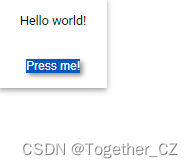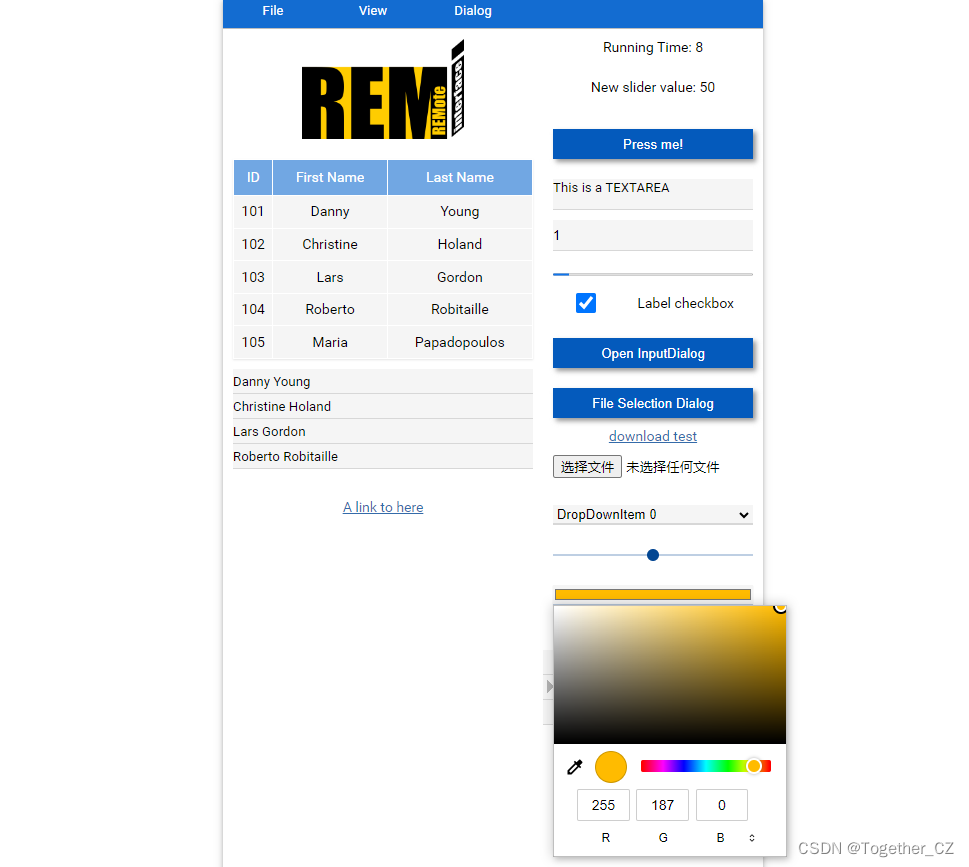In the past two days, I found a relatively interesting third-party library remi, which is mainly used for GUI development. It is developed based on python. It is very lightweight overall. The official introduction is about 100 Kbytes. The project address is here , as shown below:

So far, I have accumulated 3.4k stars, which is pretty good.
The installation method is very simple, just one line of command:
pip install remiNext we will develop a simple example, as shown below:
import remi.gui as gui
from remi import start, App
class MyApp(App):
def __init__(self, *args):
super(MyApp, self).__init__(*args)
def main(self):
container = gui.VBox(width=120, height=100)
self.lbl = gui.Label('Hello world!')
self.bt = gui.Button('Press me!')
# setting the listener for the onclick event of the button
self.bt.onclick.do(self.on_button_pressed)
# appending a widget to another, the first argument is a string key
container.append(self.lbl)
container.append(self.bt)
# returning the root widget
return container
# listener function
def on_button_pressed(self, widget):
self.lbl.set_text('Button pressed!')
self.bt.set_text('Hi!')
# starts the web server
start(MyApp, port=8081)The terminal can execute the code model. The example effect is as follows:

The effect after clicking is as follows:

Next let's look at a complex example. The core code implementation is as follows:
"""
Licensed under the Apache License, Version 2.0 (the "License");
you may not use this file except in compliance with the License.
You may obtain a copy of the License at
http://www.apache.org/licenses/LICENSE-2.0
Unless required by applicable law or agreed to in writing, software
distributed under the License is distributed on an "AS IS" BASIS,
WITHOUT WARRANTIES OR CONDITIONS OF ANY KIND, either express or implied.
See the License for the specific language governing permissions and
limitations under the License.
"""
import remi.gui as gui
from remi import start, App
from threading import Timer
class MyApp(App):
def __init__(self, *args):
super(MyApp, self).__init__(*args)
def idle(self):
self.counter.set_text('Running Time: ' + str(self.count))
self.progress.set_value(self.count%100)
def main(self):
# the margin 0px auto centers the main container
verticalContainer = gui.Container(width=540, margin='0px auto', style={'display': 'block', 'overflow': 'hidden'})
horizontalContainer = gui.Container(width='100%', layout_orientation=gui.Container.LAYOUT_HORIZONTAL, margin='0px', style={'display': 'block', 'overflow': 'auto'})
subContainerLeft = gui.Container(width=320, style={'display': 'block', 'overflow': 'auto', 'text-align': 'center'})
self.img = gui.Image('/res:logo.png', height=100, margin='10px')
self.img.onclick.do(self.on_img_clicked)
self.table = gui.Table.new_from_list([('ID', 'First Name', 'Last Name'),
('101', 'Danny', 'Young'),
('102', 'Christine', 'Holand'),
('103', 'Lars', 'Gordon'),
('104', 'Roberto', 'Robitaille'),
('105', 'Maria', 'Papadopoulos')], width=300, height=200, margin='10px')
self.table.on_table_row_click.do(self.on_table_row_click)
# the arguments are width - height - layoutOrientationOrizontal
subContainerRight = gui.Container(style={'width': '220px', 'display': 'block', 'overflow': 'auto', 'text-align': 'center'})
self.count = 0
self.counter = gui.Label('', width=200, height=30, margin='10px')
self.lbl = gui.Label('This is a LABEL!', width=200, height=30, margin='10px')
self.bt = gui.Button('Press me!', width=200, height=30, margin='10px')
# setting the listener for the onclick event of the button
self.bt.onclick.do(self.on_button_pressed)
self.txt = gui.TextInput(width=200, height=30, margin='10px')
self.txt.set_text('This is a TEXTAREA')
self.txt.onchange.do(self.on_text_area_change)
self.spin = gui.SpinBox(1, 0, 100, width=200, height=30, margin='10px')
self.spin.onchange.do(self.on_spin_change)
self.progress = gui.Progress(1, 100, width=200, height=5)
self.check = gui.CheckBoxLabel('Label checkbox', True, width=200, height=30, margin='10px')
self.check.onchange.do(self.on_check_change)
self.btInputDiag = gui.Button('Open InputDialog', width=200, height=30, margin='10px')
self.btInputDiag.onclick.do(self.open_input_dialog)
self.btFileDiag = gui.Button('File Selection Dialog', width=200, height=30, margin='10px')
self.btFileDiag.onclick.do(self.open_fileselection_dialog)
self.btUploadFile = gui.FileUploader('./', width=200, height=30, margin='10px')
self.btUploadFile.onsuccess.do(self.fileupload_on_success)
self.btUploadFile.onfailed.do(self.fileupload_on_failed)
items = ('Danny Young','Christine Holand','Lars Gordon','Roberto Robitaille')
self.listView = gui.ListView.new_from_list(items, width=300, height=120, margin='10px')
self.listView.onselection.do(self.list_view_on_selected)
self.link = gui.Link("http://localhost:8081", "A link to here", width=200, height=30, margin='10px')
self.dropDown = gui.DropDown.new_from_list(('DropDownItem 0', 'DropDownItem 1'),
width=200, height=20, margin='10px')
self.dropDown.onchange.do(self.drop_down_changed)
self.dropDown.select_by_value('DropDownItem 0')
self.slider = gui.Slider(10, 0, 100, 5, width=200, height=20, margin='10px')
self.slider.onchange.do(self.slider_changed)
self.colorPicker = gui.ColorPicker('#ffbb00', width=200, height=20, margin='10px')
self.colorPicker.onchange.do(self.color_picker_changed)
self.date = gui.Date('2015-04-13', width=200, height=20, margin='10px')
self.date.onchange.do(self.date_changed)
self.video = gui.Widget( _type='iframe', width=290, height=200, margin='10px')
self.video.attributes['src'] = "https://drive.google.com/file/d/0B0J9Lq_MRyn4UFRsblR3UTBZRHc/preview"
self.video.attributes['width'] = '100%'
self.video.attributes['height'] = '100%'
self.video.attributes['controls'] = 'true'
self.video.style['border'] = 'none'
self.tree = gui.TreeView(width='100%', height=300)
ti1 = gui.TreeItem("Item1")
ti2 = gui.TreeItem("Item2")
ti3 = gui.TreeItem("Item3")
subti1 = gui.TreeItem("Sub Item1")
subti2 = gui.TreeItem("Sub Item2")
subti3 = gui.TreeItem("Sub Item3")
subti4 = gui.TreeItem("Sub Item4")
subsubti1 = gui.TreeItem("Sub Sub Item1")
subsubti2 = gui.TreeItem("Sub Sub Item2")
subsubti3 = gui.TreeItem("Sub Sub Item3")
self.tree.append([ti1, ti2, ti3])
ti2.append([subti1, subti2, subti3, subti4])
subti4.append([subsubti1, subsubti2, subsubti3])
# appending a widget to another, the first argument is a string key
subContainerRight.append([self.counter, self.lbl, self.bt, self.txt, self.spin, self.progress, self.check, self.btInputDiag, self.btFileDiag])
# use a defined key as we replace this widget later
fdownloader = gui.FileDownloader('download test', '../remi/res/logo.png', width=200, height=30, margin='10px')
subContainerRight.append(fdownloader, key='file_downloader')
subContainerRight.append([self.btUploadFile, self.dropDown, self.slider, self.colorPicker, self.date, self.tree])
self.subContainerRight = subContainerRight
subContainerLeft.append([self.img, self.table, self.listView, self.link, self.video])
horizontalContainer.append([subContainerLeft, subContainerRight])
menu = gui.Menu(width='100%', height='30px')
m1 = gui.MenuItem('File', width=100, height=30)
m2 = gui.MenuItem('View', width=100, height=30)
m2.onclick.do(self.menu_view_clicked)
m11 = gui.MenuItem('Save', width=100, height=30)
m12 = gui.MenuItem('Open', width=100, height=30)
m12.onclick.do(self.menu_open_clicked)
m111 = gui.MenuItem('Save', width=100, height=30)
m111.onclick.do(self.menu_save_clicked)
m112 = gui.MenuItem('Save as', width=100, height=30)
m112.onclick.do(self.menu_saveas_clicked)
m3 = gui.MenuItem('Dialog', width=100, height=30)
m3.onclick.do(self.menu_dialog_clicked)
menu.append([m1, m2, m3])
m1.append([m11, m12])
m11.append([m111, m112])
menubar = gui.MenuBar(width='100%', height='30px')
menubar.append(menu)
verticalContainer.append([menubar, horizontalContainer])
#this flag will be used to stop the display_counter Timer
self.stop_flag = False
# kick of regular display of counter
self.display_counter()
# returning the root widget
return verticalContainer
def display_counter(self):
self.count += 1
if not self.stop_flag:
Timer(1, self.display_counter).start()
def menu_dialog_clicked(self, widget):
self.dialog = gui.GenericDialog(title='Dialog Box', message='Click Ok to transfer content to main page', width='500px')
self.dtextinput = gui.TextInput(width=200, height=30)
self.dtextinput.set_value('Initial Text')
self.dialog.add_field_with_label('dtextinput', 'Text Input', self.dtextinput)
self.dcheck = gui.CheckBox(False, width=200, height=30)
self.dialog.add_field_with_label('dcheck', 'Label Checkbox', self.dcheck)
values = ('Danny Young', 'Christine Holand', 'Lars Gordon', 'Roberto Robitaille')
self.dlistView = gui.ListView.new_from_list(values, width=200, height=120)
self.dialog.add_field_with_label('dlistView', 'Listview', self.dlistView)
self.ddropdown = gui.DropDown.new_from_list(('DropDownItem 0', 'DropDownItem 1'),
width=200, height=20)
self.dialog.add_field_with_label('ddropdown', 'Dropdown', self.ddropdown)
self.dspinbox = gui.SpinBox(min=0, max=5000, width=200, height=20)
self.dspinbox.set_value(50)
self.dialog.add_field_with_label('dspinbox', 'Spinbox', self.dspinbox)
self.dslider = gui.Slider(10, 0, 100, 5, width=200, height=20)
self.dspinbox.set_value(50)
self.dialog.add_field_with_label('dslider', 'Slider', self.dslider)
self.dcolor = gui.ColorPicker(width=200, height=20)
self.dcolor.set_value('#ffff00')
self.dialog.add_field_with_label('dcolor', 'Colour Picker', self.dcolor)
self.ddate = gui.Date(width=200, height=20)
self.ddate.set_value('2000-01-01')
self.dialog.add_field_with_label('ddate', 'Date', self.ddate)
self.dialog.confirm_dialog.do(self.dialog_confirm)
self.dialog.show(self)
def dialog_confirm(self, widget):
result = self.dialog.get_field('dtextinput').get_value()
self.txt.set_value(result)
result = self.dialog.get_field('dcheck').get_value()
self.check.set_value(result)
result = self.dialog.get_field('ddropdown').get_value()
self.dropDown.select_by_value(result)
result = self.dialog.get_field('dspinbox').get_value()
self.spin.set_value(result)
result = self.dialog.get_field('dslider').get_value()
self.slider.set_value(result)
result = self.dialog.get_field('dcolor').get_value()
self.colorPicker.set_value(result)
result = self.dialog.get_field('ddate').get_value()
self.date.set_value(result)
result = self.dialog.get_field('dlistView').get_value()
self.listView.select_by_value(result)
# listener function
def on_img_clicked(self, widget):
self.lbl.set_text('Image clicked!')
def on_table_row_click(self, table, row, item):
self.lbl.set_text('Table Item clicked: ' + item.get_text())
def on_button_pressed(self, widget):
self.lbl.set_text('Button pressed! ')
self.bt.set_text('Hi!')
def on_text_area_change(self, widget, newValue):
self.lbl.set_text('Text Area value changed!')
def on_spin_change(self, widget, newValue):
self.lbl.set_text('SpinBox changed, new value: ' + str(newValue))
def on_check_change(self, widget, newValue):
self.lbl.set_text('CheckBox changed, new value: ' + str(newValue))
def open_input_dialog(self, widget):
self.inputDialog = gui.InputDialog('Input Dialog', 'Your name?',
initial_value='type here',
width=500)
self.inputDialog.confirm_value.do(
self.on_input_dialog_confirm)
# here is returned the Input Dialog widget, and it will be shown
self.inputDialog.show(self)
def on_input_dialog_confirm(self, widget, value):
self.lbl.set_text('Hello ' + value)
def open_fileselection_dialog(self, widget):
self.fileselectionDialog = gui.FileSelectionDialog('File Selection Dialog', 'Select files and folders', False,
'.')
self.fileselectionDialog.confirm_value.do(
self.on_fileselection_dialog_confirm)
# here is returned the Input Dialog widget, and it will be shown
self.fileselectionDialog.show(self)
def on_fileselection_dialog_confirm(self, widget, filelist):
# a list() of filenames and folders is returned
self.lbl.set_text('Selected files: %s' % ','.join(filelist))
if len(filelist):
f = filelist[0]
# replace the last download link
fdownloader = gui.FileDownloader("download selected", f, width=200, height=30)
self.subContainerRight.append(fdownloader, key='file_downloader')
def list_view_on_selected(self, widget, selected_item_key):
""" The selection event of the listView, returns a key of the clicked event.
You can retrieve the item rapidly
"""
self.lbl.set_text('List selection: ' + self.listView.children[selected_item_key].get_text())
def drop_down_changed(self, widget, value):
self.lbl.set_text('New Combo value: ' + value)
def slider_changed(self, widget, value):
self.lbl.set_text('New slider value: ' + str(value))
def color_picker_changed(self, widget, value):
self.lbl.set_text('New color value: ' + value)
def date_changed(self, widget, value):
self.lbl.set_text('New date value: ' + value)
def menu_save_clicked(self, widget):
self.lbl.set_text('Menu clicked: Save')
def menu_saveas_clicked(self, widget):
self.lbl.set_text('Menu clicked: Save As')
def menu_open_clicked(self, widget):
self.lbl.set_text('Menu clicked: Open')
def menu_view_clicked(self, widget):
self.lbl.set_text('Menu clicked: View')
def fileupload_on_success(self, widget, filename):
self.lbl.set_text('File upload success: ' + filename)
def fileupload_on_failed(self, widget, filename):
self.lbl.set_text('File upload failed: ' + filename)
def on_close(self):
""" Overloading App.on_close event to stop the Timer.
"""
self.stop_flag = True
super(MyApp, self).on_close()
if __name__ == "__main__":
# starts the webserver
# optional parameters
# start(MyApp,address='127.0.0.1', port=8081, multiple_instance=False,enable_file_cache=True, update_interval=0.1, start_browser=True)
start(MyApp, debug=True, address='0.0.0.0', port=8081, start_browser=True, multiple_instance=True)
You can directly copy the storage and run it. The terminal execution output is as follows:

The example effect is as follows:


You can also specify the corresponding IP and port. The following is an image APP:
import time
import io
import traceback
import PIL.Image
import remi.gui as gui
from remi import start, App
import remi
class PILImageViewverWidget(gui.Image):
def __init__(self, filename=None, **kwargs):
self.app_instance = None
super(PILImageViewverWidget, self).__init__("/res:logo.png", **kwargs)
self.frame_index = 0
self._buf = None
if filename:
self.load(filename)
def load(self, file_path_name):
pil_image = PIL.Image.open(file_path_name)
self._buf = io.BytesIO()
pil_image.save(self._buf, format='png')
self.refresh()
def search_app_instance(self, node):
if issubclass(node.__class__, remi.server.App):
return node
if not hasattr(node, "get_parent"):
return None
return self.search_app_instance(node.get_parent())
def refresh(self, *args):
if self.app_instance==None:
self.app_instance = self.search_app_instance(self)
if self.app_instance==None:
return
self.frame_index = self.frame_index + 1
self.app_instance.execute_javascript("""
url = '/%(id)s/get_image_data?index=%(frame_index)s';
xhr = null;
xhr = new XMLHttpRequest();
xhr.open('GET', url, true);
xhr.responseType = 'blob'
xhr.onload = function(e){
urlCreator = window.URL || window.webkitURL;
urlCreator.revokeObjectURL(document.getElementById('%(id)s').src);
imageUrl = urlCreator.createObjectURL(this.response);
document.getElementById('%(id)s').src = imageUrl;
}
xhr.send();
""" % {'id': id(self), 'frame_index':self.frame_index})
def get_image_data(self, index=0):
try:
self._buf.seek(0)
headers = {'Content-type': 'image/png'}
return [self._buf.read(), headers]
except:
print(traceback.format_exc())
return None, None
class MyApp(App):
def __init__(self, *args):
super(MyApp, self).__init__(*args)
def main(self, name='world'):
# the arguments are width - height - layoutOrientationOrizontal
self.mainContainer = gui.Container(width=640, height=270, margin='0px auto')
self.mainContainer.style['text-align'] = 'center'
self.image_widget = PILImageViewverWidget(width=200, height=200)
self.menu = gui.Menu(width=620, height=30)
m1 = gui.MenuItem('File', width=100, height=30)
m11 = gui.MenuItem('Save', width=100, height=30)
m12 = gui.MenuItem('Open', width=100, height=30)
m12.onclick.do(self.menu_open_clicked)
m111 = gui.MenuItem('Save', width=100, height=30)
m111.onclick.do(self.menu_save_clicked)
m112 = gui.MenuItem('Save as', width=100, height=30)
m112.onclick.do(self.menu_saveas_clicked)
self.menu.append(m1)
m1.append(m11)
m1.append(m12)
m11.append(m111)
m11.append(m112)
self.mainContainer.append(self.menu)
self.mainContainer.append(self.image_widget)
# returning the root widget
return self.mainContainer
def menu_open_clicked(self, widget):
self.fileselectionDialog = gui.FileSelectionDialog('File Selection Dialog', 'Select an image file', False, '.')
self.fileselectionDialog.confirm_value.do(
self.on_image_file_selected)
self.fileselectionDialog.cancel_dialog.do(
self.on_dialog_cancel)
# here is shown the dialog as root widget
self.fileselectionDialog.show(self)
def menu_save_clicked(self, widget):
pass
def menu_saveas_clicked(self, widget):
pass
def on_image_file_selected(self, widget, file_list):
if len(file_list) < 1:
return
self.image_widget.load(file_list[0])
self.set_root_widget(self.mainContainer)
def on_dialog_cancel(self, widget):
self.set_root_widget(self.mainContainer)
if __name__ == "__main__":
start(MyApp, address='0.0.0.0', port=0, start_browser=True)
The official project also provides many examples. If you are interested, you can take a closer look.
Later, we will consider how to combine this set of visualization projects with models to create a very useful product. If you are interested, you can try it!